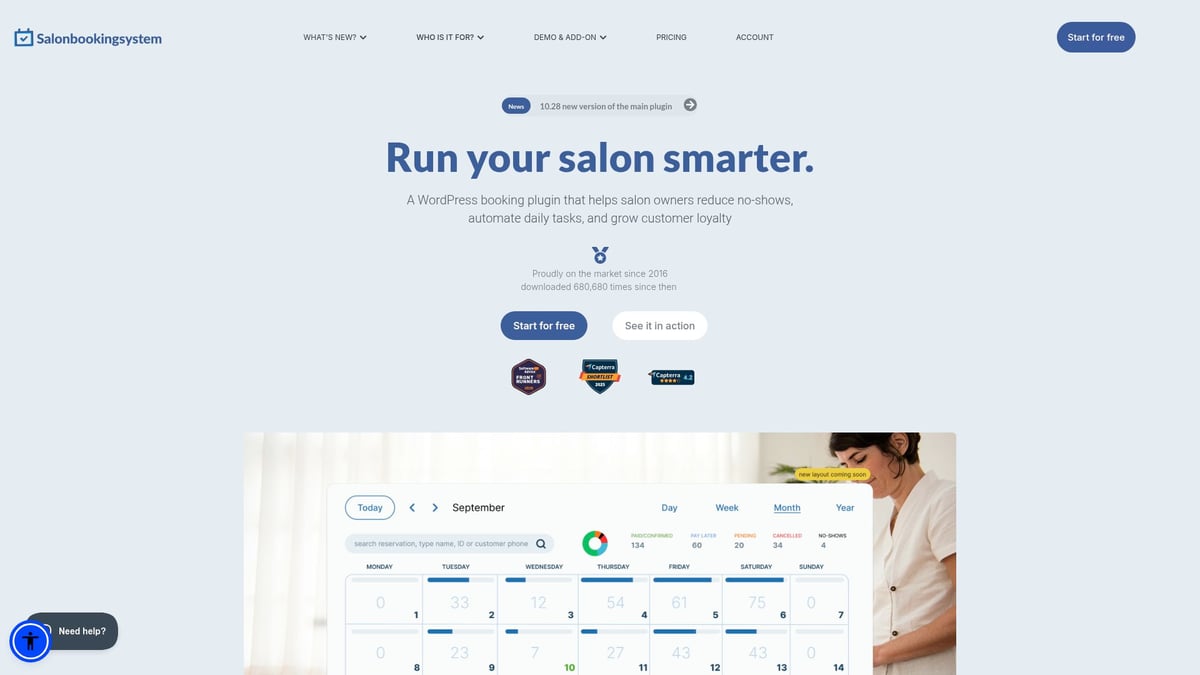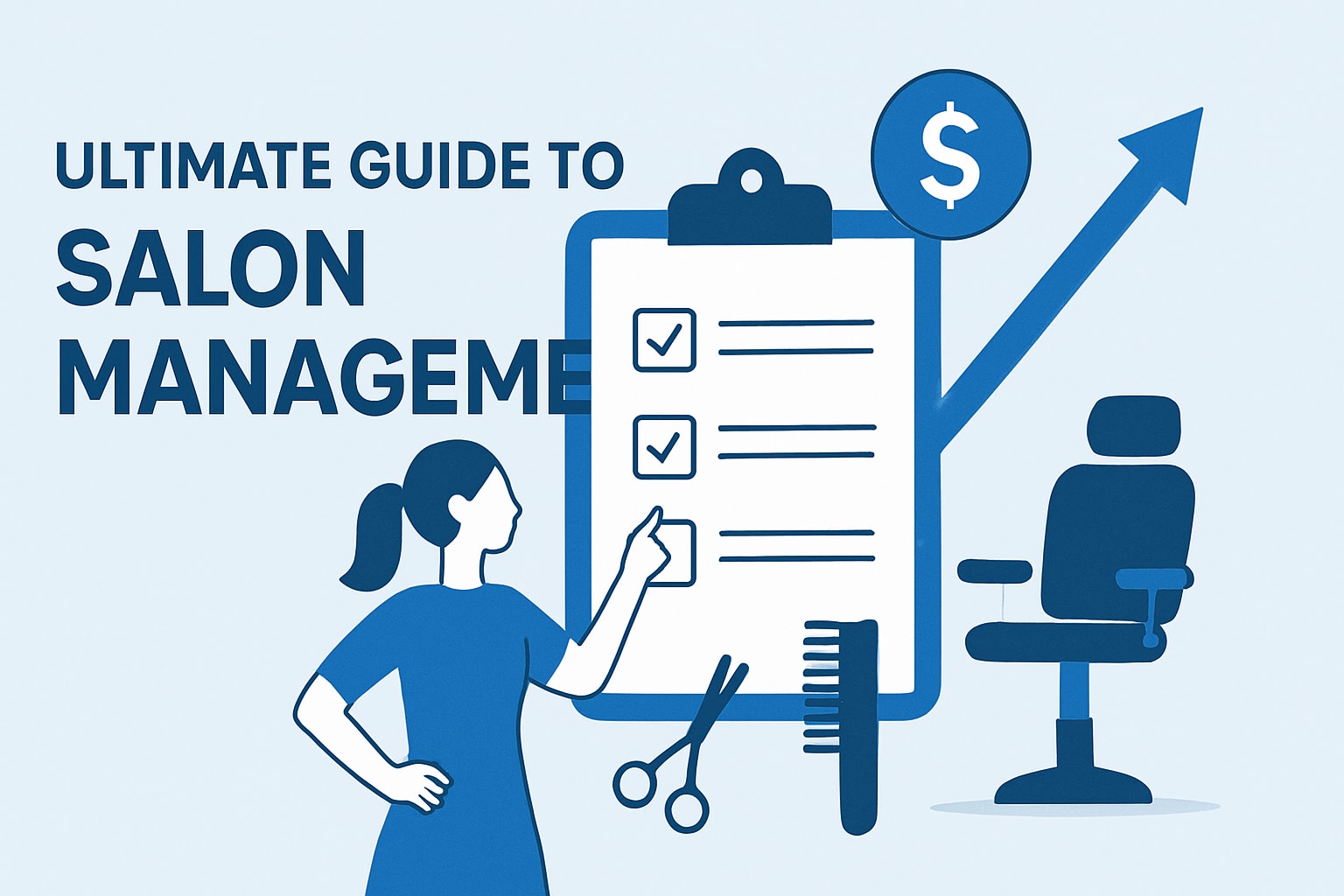Salon management is entering a new era, shaped by rapid technological change and shifting client expectations. To thrive in 2025, leaders must stay ahead of these trends and embrace innovation.
This guide provides a clear roadmap for effective salon management. Explore the latest industry trends, advanced technology integration, staff development, enhanced customer experiences, robust financial controls, marketing strategies, and compliance essentials.
Facing fierce competition and evolving regulations, salons have both challenges and new opportunities. Learn how digital transformation, personalized client care, and best practices can set your business apart.
Ready to future proof your salon management? Take action and implement these expert strategies for lasting growth and excellence.
The Evolving Landscape of Salon Management in 2025
Salon management is entering a dynamic new era in 2025. Owners and managers face a rapidly shifting landscape, where adaptability is crucial to thrive. The integration of technology, changing consumer values, and new business models are shaping the way salons operate, deliver services, and compete.

Key Industry Trends and Future-Proofing Your Salon
The most successful salon management strategies in 2025 recognize the need for hybrid business models. Salons are blending in-person appointments with virtual consultations, allowing clients to access expert advice from anywhere. This flexibility not only expands reach but also meets evolving client expectations for convenience.
Personalization is at the forefront. Clients now expect tech-enabled experiences, such as AI-powered service recommendations and seamless digital booking. Automation is streamlining daily operations, from inventory control to client communications, freeing up staff for higher-value interactions.
Sustainability is no longer optional. More salons are adopting eco-friendly products, reducing waste, and prioritizing responsible sourcing. These efforts resonate with environmentally conscious clients and can set a salon apart.
Data-driven decision-making is critical. Salon management teams are leveraging analytics to optimize service menus, track client preferences, and refine marketing strategies. Keeping pace with health and safety regulations remains vital, as post-pandemic standards evolve.
Finally, a growing number of salons are integrating wellness and holistic beauty services. This trend provides a unique competitive edge, responding to a broader client desire for self-care and well-being.
Here is a summary of the top trends shaping salon management:
| Trend | Description |
|---|---|
| Hybrid Models | In-person and virtual consults |
| Personalization & Tech | AI, automation, digital experiences |
| Sustainability | Eco-friendly products, waste reduction |
| Data-Driven Decisions | Analytics for smarter management |
| Wellness Services | Holistic beauty and self-care offerings |
For a deeper dive into these developments, see the Salon Industry Trends 2025 report, which explores how technology and sustainability are transforming the industry.
Statistics & Insights
Industry data underscores the urgency to innovate. According to Rippling, 70% of salons plan to boost digital investments this year. This reflects a widespread recognition that digital transformation is essential for effective salon management.
Salons that have adopted AI and automation report significant improvements in customer engagement and operational efficiency. For example, some have reduced administrative workload and cut no-shows by integrating automated messaging and online scheduling.
Consumer behavior is shifting as well. Reports reveal that clients are more likely to choose salons offering personalized, tech-driven experiences and visible sustainability initiatives. Salons that pivoted quickly during recent disruptions, such as adding virtual consultations or implementing eco-friendly practices, have outperformed competitors.
By staying informed on these trends and leveraging data, salon management professionals can make strategic decisions that lead to long-term success. The landscape will continue to evolve, but those who adapt proactively will be best positioned to lead the industry forward.
Leveraging Technology for Seamless Operations
Technology is transforming salon management at every level. As salons embrace digital tools, they gain efficiency, reduce errors, and deliver elevated experiences for both clients and staff. The right solutions not only streamline daily tasks but also provide a competitive edge in a rapidly evolving industry.
Implementing Salon Management Software and Automation
Adopting comprehensive platforms is foundational for effective salon management. These systems centralize client records, appointments, payments, and analytics, minimizing manual work and human error.
Key features to prioritize include:
- Online booking and automated reminders
- Integrated point-of-sale (POS) for seamless transactions
- Real-time analytics for data-driven decisions
- Inventory management with automated stock alerts
- Staff scheduling and payroll integration
Consider this table comparing essential features:
| Feature | Impact on Operations | Client Benefit |
|---|---|---|
| Online Booking | Reduces admin workload | 24/7 self-service access |
| Automated Reminders | Cuts no-shows by up to 30% | Fewer forgotten visits |
| Integrated POS | Fast, error-free checkout | Multiple payment options |
| Analytics Dashboard | Tracks KPIs in real time | Personalized offers |
Salons that invest in robust software report measurable improvements. For example, automated notifications can reduce no-shows significantly. By leveraging platforms with these capabilities, salon management teams free up time to focus on growth and service quality.
For a deeper dive into must-have features, explore this Salon Booking System Features resource, which details the latest advancements in salon management software.
Integrating AI and Smart Tools
Artificial intelligence is revolutionizing salon management by powering advanced personalization and operational efficiency. AI-driven platforms can analyze client history to recommend new services or products tailored to individual preferences.
Smart devices further streamline daily routines. Automated inventory tracking helps avoid stockouts, while energy management tools optimize utility use and reduce costs. Virtual consultations allow stylists to connect with clients remotely, offering advice or pre-visit assessments.
Augmented reality (AR) is also making waves. Clients can preview hair colors or styles in real time, leading to more confident decisions and increased upselling of retail products. Salons using AR report higher product sales and improved client engagement.
By integrating AI and smart technologies, salon management can deliver a seamless, modern experience that sets the business apart from competitors.
Salon Booking System: Modern Scheduling Solutions for 2025
Efficient appointment management is at the heart of successful salon management. The Salon Booking System addresses common scheduling challenges with a user-friendly interface, secure online payments, and automated customer notifications.

Key features include:
- Advanced scheduling that accommodates staff specialties and room availability
- Easy rescheduling and waitlist management
- Real-time updates for both clients and staff
- Comprehensive reporting for operational insights
Salons adopting this solution have seen administrative workloads reduced and client satisfaction rise. With proven results since 2016, the Salon Booking System empowers teams to focus on delivering exceptional service rather than managing paperwork.
By leveraging advanced technology, salon management in 2025 can achieve seamless operations, boost efficiency, and create memorable experiences for every client.
Building and Empowering High-Performing Teams
A successful salon thrives on the strength and cohesion of its team. In 2025, salon management demands more than skillful stylists; it requires a culture of learning, engagement, and leadership that supports both staff and business goals.

Recruitment, Training, and Retention Strategies
Attracting top talent is the first step toward building a high-performing team. With competition rising, salon management must focus on employer branding and clear value propositions to draw skilled professionals.
Effective onboarding sets the tone for new hires. Provide structured orientation, introduce company culture, and ensure all staff understand core processes. Continuous education is vital; regular training keeps your team ahead of trends and techniques. Many leading salons offer monthly workshops, resulting in up to 20 percent higher staff retention rates.
Cross-training is another key strategy. By teaching staff multiple roles, you create operational flexibility and resilience. Employee engagement should be a constant priority. Foster an inclusive, positive workplace through recognition programs, open feedback channels, and career development opportunities.
Performance management tools help track progress and set clear goals. Regular, constructive feedback motivates staff and identifies growth areas. For actionable advice on training and integrating technology into your team’s workflow, explore Salon Management Blog Tutorials.
By investing in these areas, salon management can build loyalty and reduce turnover, ensuring consistent service and client satisfaction.
Leadership and Communication
Strong leadership is the backbone of effective salon management. Transparent, two-way communication builds trust and keeps staff aligned with business objectives.
Hold regular team meetings to discuss goals, share updates, and brainstorm solutions. This practice encourages collaboration and keeps everyone informed. Address challenges proactively—conflict resolution should be handled with empathy and professionalism.
Workplace stress is inevitable, but leaders who listen and provide support foster a healthier environment. Empower your staff to contribute ideas, take initiative, and own the client experience. When team members feel valued, they are more engaged and productive.
Encourage open dialogue and celebrate successes together. This approach not only boosts morale but also drives innovation within your salon management strategy.
By nurturing leadership and communication, you create a culture of excellence that attracts and retains top talent, setting your salon apart in a competitive market.
Delivering Exceptional Customer Experiences
Delivering standout customer experiences is now a defining factor for salon management success in 2025. Clients expect more than just top-notch services—they want personalization, convenience, and genuine care at every touchpoint. By embracing smart strategies and digital tools, salons can exceed expectations and build lasting loyalty.

Personalization and Client Care in 2025
Personalization is at the heart of effective salon management. In 2025, leveraging client data allows salons to customize every interaction, from tailored service recommendations to personalized offers. This approach makes clients feel truly valued and understood.
Creating a memorable in-salon experience means paying attention to ambiance, amenities, and hospitality. Thoughtful touches, such as welcome drinks or curated playlists, help clients relax and enjoy their visit. A warm and inviting environment remains a key driver of client satisfaction in salon management.
Consultations are essential for understanding each client's unique needs. Encourage open communication, ask detailed questions, and record preferences for future visits. This level of attention sets your salon apart and builds trust over time.
Loyalty programs are another cornerstone of successful salon management. Offering points, rewards, or exclusive experiences encourages repeat visits and deeper engagement. Consider options like referral bonuses, birthday perks, or tiered membership benefits to keep clients coming back.
Managing feedback is equally important. Actively seek reviews through digital platforms or in-salon kiosks, and respond constructively to both praise and concerns. Salons that maintain active feedback loops consistently improve their client satisfaction scores and build a reputation for attentive service.
A table summarizing personalization strategies:
| Strategy | Impact on Client Experience | Role in Salon Management |
|---|---|---|
| Tailored Offers | Boosts relevance and engagement | Increases retention |
| Personalized Consults | Builds trust and addresses specific needs | Enhances reputation |
| Loyalty Programs | Rewards loyalty and encourages repeat business | Grows client base |
| Feedback Management | Improves services and client satisfaction | Drives continuous improvement |
Efficient Appointment and Queue Management
Efficient appointment and queue management are vital components of modern salon management. Clients value their time, so minimizing wait times and streamlining check-in processes are essential for a positive experience.
Optimized scheduling helps balance walk-ins and pre-booked clients. Digital tools, such as booking apps and kiosks, empower clients to select services, confirm appointments, and check in quickly. This not only reduces administrative workload but also enhances the overall flow of salon operations.
Automated reminders and confirmations are highly effective in reducing no-shows. By sending timely notifications via SMS or email, salons can ensure clients remember their appointments, leading to fewer gaps in the schedule.
For busy salons, managing queues efficiently is a must. Digital queue systems provide transparency, allowing clients to track their place in line and estimate wait times. This transparency improves satisfaction and reduces frustration.
According to Beauty Booking System Insights, salons adopting modern booking systems report significant improvements in appointment management and client retention. These solutions support seamless scheduling, reduce errors, and deliver a smoother client journey, all of which are crucial for effective salon management.
Incorporating technology into appointment and queue management not only boosts efficiency but also positions your salon as an industry leader. Clients notice the difference and are more likely to return for future services.
Financial Management and Revenue Optimization
Effective financial management is the backbone of successful salon management. As salons enter 2025, owners must adopt proactive strategies to ensure long-term profitability and resilience. By mastering budgeting, optimizing costs, and leveraging smart technology, your salon can thrive in a rapidly evolving market.
Budgeting, Cost Control, and Profitability
A comprehensive budget is the foundation of robust salon management. Begin by categorizing expenses into fixed costs, such as rent and salaries, and variable costs like supplies, utilities, and marketing. This clarity allows you to anticipate cash flow needs and set realistic revenue targets.
Monitoring key performance indicators (KPIs) is essential. Track metrics such as average ticket size, client retention rate, and retail sales percentage. Regularly reviewing these numbers helps you identify trends and adjust your salon management strategy as needed.
Cost-saving measures can significantly improve your bottom line. Consider these practical tactics:
- Negotiate bulk purchasing agreements with suppliers for better rates.
- Implement energy-efficient lighting and appliances to reduce utility costs.
- Analyze service menus to eliminate low-margin offerings.
Diversifying revenue streams is another pillar of strong salon management. Retail sales, memberships, and bundled service packages can boost profits. According to industry insights, salons that invest in retail sales can increase profits by up to 15%. For more data on industry trends and financial benchmarks, review the latest Salon Industry Statistics 2025.
Dynamic pricing strategies, such as offering discounts during off-peak hours or premium pricing for in-demand stylists, provide additional flexibility. Regular scenario planning and financial reviews will help you stay agile in a changing landscape.
Leveraging Financial Technology
Integrating financial technology is transforming salon management. Modern accounting software tailored for salons streamlines bookkeeping, automates payroll, and provides real-time financial insights. This minimizes manual errors and frees up time for business growth activities.
Point-of-sale (POS) systems, when connected with inventory and client management platforms, create a seamless operational flow. These systems allow for accurate sales tracking, automated inventory updates, and instant reporting. Staff can focus more on client service, knowing that administrative tasks are efficiently handled.
Digital tools also support scenario planning and forecasting. Use financial dashboards to visualize revenue trends and identify areas for improvement. Automated reminders for bill payments and expense tracking reduce the risk of missed deadlines or overspending.
Regular financial reviews are crucial. Set a monthly schedule to analyze profit and loss statements, cash flow reports, and budget variances. This proactive approach enables salon management teams to make informed decisions quickly.
Embracing financial technology not only drives profitability but also positions your salon for growth. By staying current with tools and trends, your business is better equipped to navigate the challenges and opportunities of 2025.
Marketing, Branding, and Client Acquisition in a Digital World
The world of salon management is being transformed by the rapid rise of digital channels and evolving client expectations. To stay ahead in 2025, salon owners must embrace new marketing strategies that reach clients both online and within their communities.
Digital Marketing Strategies for 2025
Salon management now demands a robust online presence. Your website, Google My Business, and directories must be current, visually appealing, and optimized for search. Social media marketing is essential, especially on platforms like Instagram, Facebook, and TikTok, where visual storytelling attracts new clients. In fact, salons with active Instagram accounts see 40 percent higher new client acquisition.
A strong digital approach also includes email and SMS campaigns. These channels are effective for promoting new services, sharing exclusive offers, and reminding clients about appointments. Personalization, such as segmenting your audience by service history, enhances engagement and drives repeat business.
User-generated content and online reviews are powerful trust builders. Encourage satisfied clients to post before-and-after photos or reviews on social platforms. This not only boosts credibility but also increases your salon's visibility in search results. Tracking analytics allows you to measure ROI and adjust strategies quickly, ensuring that every marketing dollar counts.
According to recent consumer behavior changes in salons, clients are seeking more digital convenience and transparency than ever before. Salon management teams who monitor these trends can adapt faster, tailoring marketing efforts to what clients value most.
A/B testing different promotions or content types will help you discover what resonates best. Consider the table below for a quick comparison of digital marketing channels:
| Channel | Strengths | Use Case |
|---|---|---|
| Visual impact, engagement | Showcasing styles, promos | |
| Direct, personalized | Announcements, loyalty offers | |
| Google My Biz | Local search, reviews | Attracting walk-ins |
By integrating these digital strategies, salon management can fuel both client acquisition and retention.
Local and Community Engagement
While digital tools are crucial, salon management thrives when combined with local outreach. Partnering with nearby businesses, hosting events, and supporting charities can set your salon apart. These activities foster brand loyalty and create memorable experiences that clients want to share.
Workshops, pop-up experiences, and open houses are great ways to introduce new services or products. They also provide opportunities for clients to interact with your team and learn about your expertise. Storytelling is another powerful tool—share your salon's journey, values, and community involvement on your website and social channels.
Building relationships with local influencers or community leaders can amplify your reach. Collaboration on events or campaigns brings fresh audiences and shows your commitment to the neighborhood. This personal touch is often what keeps clients coming back.
For inspiration, explore case studies for salons that have successfully blended digital marketing with impactful community initiatives. These examples highlight the importance of aligning your salon management strategy with local values and needs.
Community engagement also provides valuable feedback on your services. Listen to client suggestions during events or through follow-ups, and use these insights to refine your offerings.
By balancing innovative digital tactics with genuine local connections, salon management teams can build a loyal client base and elevate their brand in 2025.
Compliance, Health, and Safety: Staying Ahead of Regulations
Staying ahead in salon management means making compliance, health, and safety top priorities. As regulations continue to evolve, salon owners must adapt quickly to protect both clients and staff. These standards are not just requirements, but also opportunities to build trust, reputation, and long-term business growth.
Meeting 2025 Standards and Building Trust
Regulatory standards for salon management in 2025 are more comprehensive than ever before. Owners must keep up with local, state, and national guidelines for sanitation, cleaning, and record-keeping. These requirements cover everything from disinfecting tools after each use to maintaining detailed logs of cleaning routines.
A strong compliance program starts with staff education. Training should cover hygiene protocols, emergency procedures, and the correct use of personal protective equipment. Regular refresher sessions help reinforce best practices and keep everyone up to date.
Accessibility and inclusivity are also essential. Salons should ensure ADA compliance and adapt services to meet the needs of clients with disabilities or diverse backgrounds. This includes barrier-free entryways, adjustable chairs, and accessible restrooms.
Data privacy is another critical aspect of salon management. With digital records and online booking systems, salons must comply with laws like GDPR and obtain proper client consent for storing personal information. Protecting client data builds confidence and sets your business apart.
Visible hygiene protocols can have a powerful impact. Salons that display cleaning schedules, provide hand sanitizer at entrances, and communicate safety measures often see increased client trust and repeat visits. According to industry reports, these practices are becoming standard as clients prioritize health and transparency.
For more on how industry leaders are navigating regulatory changes and market growth, see the Global Salon Market Growth report.
Risk Management and Insurance
Effective salon management requires a proactive approach to risk management. Regular risk assessments help identify hazards such as slippery floors, chemical storage issues, or outdated equipment. Documenting these findings and acting on them reduces the chance of incidents.
Insurance is a key safeguard for any salon. Comprehensive coverage should include liability, property, and workers’ compensation policies. Reviewing and updating these policies annually ensures the business is protected against emerging risks.
Staff should be trained on emergency procedures, including fire safety, first aid, and evacuation plans. Posting emergency contact information and conducting regular drills will keep everyone prepared.
Staying informed about changing regulations is crucial. Subscribe to industry newsletters, attend training sessions, and network with other salon owners to stay ahead. This ongoing commitment to compliance is not just a legal necessity, but a cornerstone of responsible salon management.
By integrating these strategies, salons can create a safer environment, minimize liability, and build lasting trust with clients.
As you look ahead to managing your salon in 2025, embracing new technology, delivering personalized experiences, and streamlining daily operations will be crucial for lasting success. If you are ready to put these strategies into action and want a practical tool to help you simplify appointment scheduling, boost efficiency, and keep your clients happy, why not take the next step today? You can explore all the benefits of a trusted, user friendly platform for yourself—no commitment required. Start for free and see how easy it is to future proof your salon.




